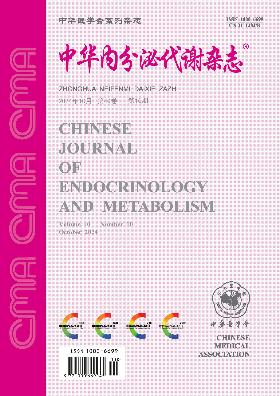Study on glycemic profiles and emotional scales in diabetic patients after the outbreak of COVID-19
Q4 Medicine
引用次数: 1
Abstract
Objective: To observe the glycemic profiles and emotion management in diabetic patients after the outbreak of novel coronavirus disease 2019(COVID-19) Methods: A questionnaire survey was used to observe the blood glucose levels and metabolic indexes before and after the outbreak of COVID-19, and to detect emotion ratings after the outbreak of COVID-19 The aim of the study is to present the effects of the COVID-19 on glycemic and emotional management in diabetic patients Results: A total of 136 patients were included in this survey The average age of the patients was 62 5 years old, and the average duration of diabetes was 10 1 years Glycemic profiles(fasting blood glucose, 2 h postprandial blood glucose, HbA1C), lipid profiles(triglycerides, low-density lipoprotein cholesterol), and body weight were not significantly different before and after the outbreak of COVID-19(P>0 05) According to emotional scales(scores of anxiety, depression, and sleep-related scales), 76 5% diabetic patients did not develop anxiety symptoms, 61 0%~69 9% diabetic patients did not have depressive symptoms and 52 0% diabetic patients did not have sleep disorder 19 9% diabetic patients had mild anxiety symptoms, 25 7%~30 9% diabetic patients presented mild depression symptoms and 28 3% diabetic patients had mild sleep disorders 2 9% diabetic patients had moderate anxiety, 2 2%~8 1% diabetic patients had moderate depression and 14 2% diabetic patients had moderate sleep disorder Only a very small part of patients presented severe emotional symptoms including 0 7% patients with anxiety symptoms(GAD-7 15 points and above), 2 2% patients with depressive symptoms(PHQ9 and PHQ15 15 points and above)and 5 6% patients with sleep symptoms(PSQI 15 points and above) Compared with asymptomatic patients, neither patients with mild and moderate/severe depression and sleep disorder showed significant difference in HbA1C, nor did patients with moderate/ severe anxiety symptoms However, patients with mild anxiety symptoms showed significant lower HbA1C than asymptomatic patients Conclusion: After the outbreak of COVID-19, there was an increasing trend in blood glucose, but there was no statistical difference Body weight, lipids profiles were not different in diabetic patients, either Most of diabetic patients had mild symptoms of anxiety, depression and sleep disorders Very few patients presented moderate to severe symptoms of anxiety, depression and sleep disorders Copyright © 2020 by the Chinese Medical Association新冠肺炎疫情后糖尿病患者血糖及情绪量表的研究
目的:观察2019年新型冠状病毒病(COVID-19)暴发后糖尿病患者的血糖状况及情绪管理情况。方法:采用问卷调查法,观察2019年新型冠状病毒病(COVID-19)暴发前后血糖水平及代谢指标,并检测疫情暴发后的情绪评分。本次调查共纳入136例患者,患者平均年龄为62.5岁,糖尿病平均病程为101年,血糖(空腹血糖、餐后2小时血糖、HbA1C)、血脂(甘油三酯、低密度脂蛋白胆固醇)、体重在新冠肺炎爆发前后无显著差异(P>0 05)。76 %的糖尿病患者无焦虑症状,61 0%~69 9%的糖尿病患者无抑郁症状,52 %的糖尿病患者无睡眠障碍,19 9%的糖尿病患者有轻度焦虑症状,25 7%~30 9%的糖尿病患者有轻度抑郁症状,28 3%的糖尿病患者有轻度睡眠障碍,2 9%的糖尿病患者有中度焦虑。仅有极少数患者出现严重情绪症状,其中焦虑症状(GAD-7 15分及以上)占0.7%,抑郁症状(PHQ9和PHQ15 15分及以上)占2.2%,睡眠症状(PSQI 15分及以上)占5.6%,与无症状患者相比。轻、中/重度抑郁和睡眠障碍患者的HbA1C无显著差异,中/重度焦虑症状患者的HbA1C也无显著差异,但轻度焦虑症状患者的HbA1C明显低于无症状患者。新冠肺炎疫情发生后,糖尿病患者的血糖呈上升趋势,但无统计学差异。糖尿病患者的体重、血脂谱无统计学差异,大多数糖尿病患者表现为轻度焦虑、抑郁和睡眠障碍症状,极少数患者表现为中度至重度焦虑、抑郁和睡眠障碍症状版权所有©中华医学会2020
本文章由计算机程序翻译,如有差异,请以英文原文为准。
求助全文
约1分钟内获得全文
求助全文
来源期刊

中华内分泌代谢杂志
Medicine-Endocrinology, Diabetes and Metabolism
CiteScore
0.60
自引率
0.00%
发文量
7243
期刊介绍:
The Chinese Journal of Endocrinology and Metabolism was founded in July 1985. It is a senior academic journal in the field of endocrinology and metabolism sponsored by the Chinese Medical Association. The journal aims to be the "Chinese broadcaster of new knowledge on endocrinology and metabolism worldwide". It reports leading scientific research results and clinical diagnosis and treatment experience in endocrinology and metabolism and related fields, as well as basic theoretical research that has a guiding role in endocrinology and metabolism clinics and is closely integrated with clinics. The journal is a core journal of Chinese science and technology (a statistical source journal of Chinese science and technology papers), and is included in Chinese and foreign statistical source journal databases such as the Chinese Science and Technology Papers and Citation Database, Chemical Abstracts, and Scopus.
 求助内容:
求助内容: 应助结果提醒方式:
应助结果提醒方式:


